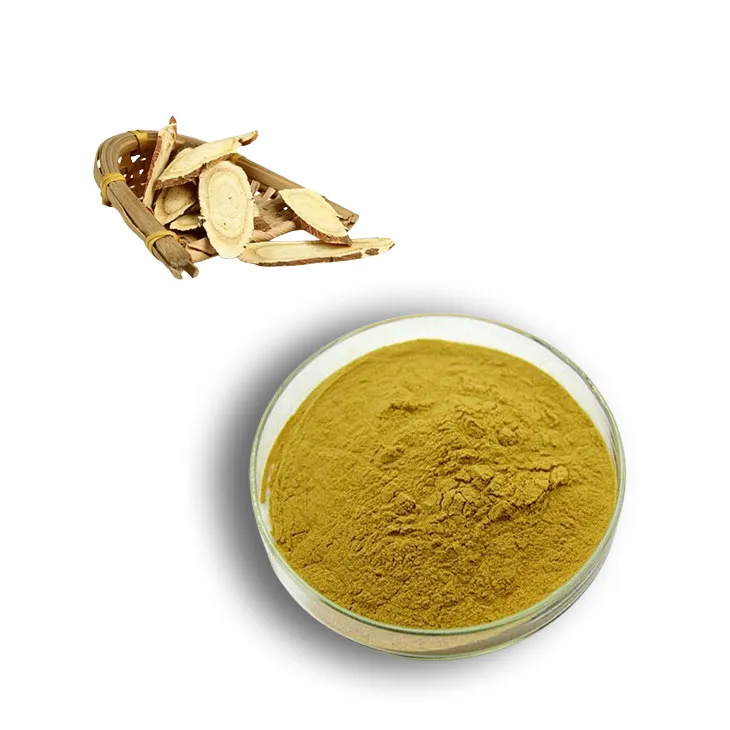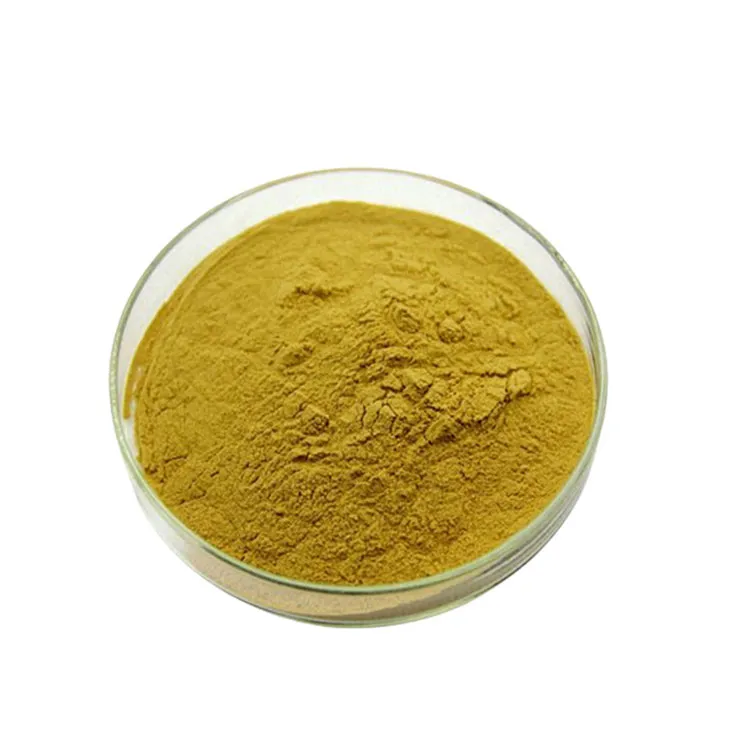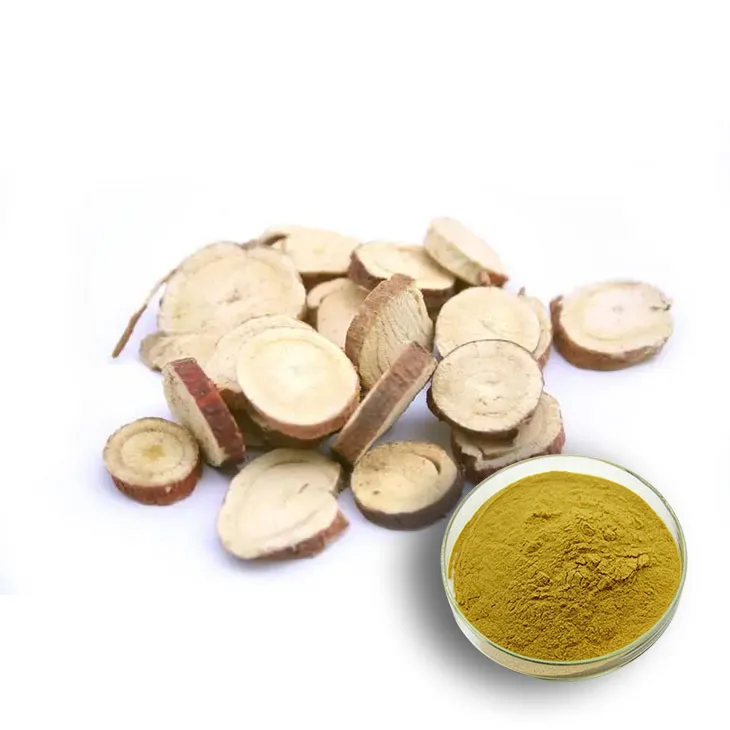- 0086-571-85302990
- sales@greenskybio.com
Organic Licorice Root Extract Powder Factory.
2024-11-28

Introduction
An organic Licorice Root Extract Powder factory plays a crucial role in the production and supply of this highly valuable natural product. Licorice root has been used for centuries in various cultures for its numerous health benefits and unique flavor profile. In modern times, the demand for organic products has led to the establishment of specialized factories dedicated to the extraction of licorice root in an organic and sustainable manner.

Organic Cultivation of Licorice Roots
The process begins with the organic cultivation of licorice roots. Organic farming practices ensure that the licorice plants grow in an environment that is free from synthetic fertilizers, pesticides, and other harmful chemicals. This is of utmost importance as it directly impacts the quality and purity of the final product.
Soil Preparation
Organic farmers carefully prepare the soil for licorice cultivation. They often use natural compost and organic matter to enrich the soil, providing the necessary nutrients for the plants to thrive. This not only promotes healthy growth but also helps in maintaining the ecological balance of the soil.
Water Management
Proper water management is another key aspect of organic licorice root cultivation. The plants require an appropriate amount of water at different stages of growth. Organic farmers use techniques such as drip irrigation to ensure that water is used efficiently and that the roots are not water - logged, which could lead to root rot.
Pest and Disease Control
Instead of relying on chemical pesticides, organic farmers use natural methods to control pests and diseases. For example, they may introduce beneficial insects that prey on pests, or use plant - based extracts with pesticidal properties. In case of diseases, they focus on prevention through proper plant spacing and good air circulation.

The Extraction Process
Once the licorice roots are harvested, they are sent to the factory for extraction. The extraction process in an organic Licorice Root Extract Powder factory is a sophisticated combination of traditional knowledge and modern technology.
Cleaning and Preparation
The first step in the extraction process is the cleaning of the licorice roots. This involves removing any dirt, debris, or unwanted plant parts. After cleaning, the roots are often cut or ground into smaller pieces to increase the surface area for extraction.
Extraction Using Advanced Equipment
The factory uses state - of - the - art equipment for extraction. These machines are designed to extract the active ingredients from the licorice root while preserving their integrity. One common method is solvent extraction, where a suitable solvent is used to dissolve the desired compounds from the root material. The solvent is then carefully removed to obtain the concentrated extract.
Drying and Powder Formation
After extraction, the resulting liquid extract is dried to remove the remaining moisture. This can be done using techniques such as spray drying or freeze - drying. Once dried, the extract is further processed into a fine powder. The powder form is more convenient for various applications, such as in the food and pharmaceutical industries.

Applications of Organic Licorice Root Extract Powder
The organic licorice root extract powder produced by the factory has a wide range of applications across different industries.
Food Industry
- In the food industry, it is used as a natural sweetener. Licorice root extract powder has a sweet taste that can be used to replace artificial sweeteners in some products. This is especially appealing to consumers who are looking for natural alternatives.
- It also adds a unique flavor to food products. It can be used in confectionery, such as candies and chocolates, to give a distinct licorice flavor. Additionally, it can be added to beverages like tea and coffee for a subtle flavor enhancement.
- Moreover, the extract powder has certain health - promoting properties. It contains antioxidants and anti - inflammatory compounds, which can be beneficial when incorporated into functional foods.
Herbal Medicine
- In herbal medicine, organic licorice root extract powder is highly regarded. It has a long history of use in traditional medicine systems for its ability to support the digestive system. It can help soothe the stomach, relieve indigestion, and reduce stomach acidity.
- It also has immunomodulatory effects, which means it can help regulate the immune system. This makes it potentially useful in the prevention and treatment of certain diseases.
- Furthermore, licorice root extract has been studied for its potential anti - viral and anti - bacterial properties, although more research is needed in these areas.
Cosmetics and Skincare
- The extract powder is finding its way into the cosmetics and skincare industry. It has moisturizing properties and can help improve the skin's hydration levels. This makes it suitable for use in creams, lotions, and other skincare products.
- It also has anti - inflammatory properties that can be beneficial for treating skin conditions such as eczema and psoriasis. Some products claim that licorice root extract can help reduce skin redness and irritation.

Research and Development in the Factory
An important aspect of an organic licorice root extract powder factory is its focus on research and development (R & D). R & D activities are essential for the continuous improvement of the production process and the discovery of new applications for the extract powder.
Enhancing Extraction Efficiency
- Scientists in the factory are constantly exploring ways to enhance the extraction efficiency. This involves researching new extraction methods, optimizing the existing processes, and finding better solvents or extraction conditions. By improving extraction efficiency, the factory can increase the yield of the active ingredients and reduce production costs.
- They also study the impact of different factors such as temperature, pressure, and extraction time on the quality and quantity of the extract. This knowledge is then used to fine - tune the extraction process.
Discovering New Potential Uses
- Another area of R & D is the discovery of new potential uses for the licorice root extract powder. With the growing interest in natural products, there is a vast potential for finding new applications in fields such as nutraceuticals, sports supplements, and even in the treatment of complex diseases.
- Researchers are conducting in - vitro and in - vivo studies to understand the biological activities of the extract powder at a molecular level. This research can lead to the identification of new health benefits and the development of new products based on licorice root extract.
Sustainable Production Methods
The organic licorice root extract powder factory is committed to sustainable production methods. This is not only important for the environment but also for the long - term availability of licorice root.
Resource Conservation
- The factory focuses on conserving resources such as water and energy during the production process. For example, they may use energy - efficient equipment for extraction and drying, and implement water - recycling systems to reduce water consumption.
- They also strive to minimize waste generation. Any by - products or waste materials from the extraction process are either recycled or disposed of in an environmentally friendly manner.
Protecting the Ecosystem
- By following organic farming practices for licorice root cultivation, the factory helps protect the local ecosystem. Organic farming promotes biodiversity, as it does not use harmful chemicals that can disrupt the natural balance of the ecosystem.
- The factory also takes measures to prevent soil erosion and protect water sources. For example, they may plant cover crops to hold the soil in place and implement proper drainage systems to prevent water pollution.
Fair Trade and Community Support
- In some cases, the factory may be involved in fair trade practices. This ensures that the farmers who grow the licorice roots are paid a fair price for their produce. Fair trade also promotes sustainable farming practices among the farmers, as they are rewarded for their efforts in producing high - quality organic licorice roots.
- The factory may also support the local community through various initiatives such as providing employment opportunities, education, and healthcare facilities. This helps in the overall development of the community where the licorice root is cultivated and the factory is located.
Conclusion
The organic licorice root extract powder factory is a complex and multi - faceted operation. It combines the principles of organic cultivation, advanced extraction technology, diverse applications, research and development, and sustainable production methods. By understanding the various aspects of such a factory, we can appreciate the value of this natural product and the efforts made to produce it in an environmentally friendly and sustainable manner. As the demand for natural and organic products continues to grow, the role of these factories will become even more important in the future.
FAQ:
What are the main benefits of using organic licorice root extract powder in the food industry?
Organic licorice root extract powder can be used as a natural sweetener in the food industry. It also has additional health benefits. For example, it contains certain compounds that may have positive effects on the body, which makes it a more favorable alternative to artificial sweeteners.
How does the factory ensure the quality of the organic licorice root extract powder?
The factory ensures quality in multiple ways. Firstly, the licorice roots are organically cultivated, growing in an environment free from synthetic fertilizers and harmful chemicals. During extraction, state - of - the - art equipment is used to preserve the active ingredients. Additionally, the factory may have quality control measures in place throughout the production process to test for purity, potency, and safety.
What role does research and development play in an organic licorice root extract powder factory?
Research and development in the factory is crucial. Scientists are constantly exploring new ways to enhance extraction efficiency. They also aim to discover new potential uses for the extract powder. This helps the factory stay competitive in the market and expand the applications of the product, whether in the food, herbal medicine, or other industries.
How does the extraction process in the factory preserve the active ingredients of licorice root?
The factory uses state - of - the - art extraction equipment. The extraction process is carefully designed to be gentle enough to not damage or destroy the active ingredients present in the licorice root. Specific parameters such as temperature, pressure, and solvents (if used) are likely optimized to ensure the integrity of these important components.
Why is sustainable production important for an organic licorice root extract powder factory?
Sustainable production is important for several reasons. Firstly, it protects the environment. By using sustainable methods, the factory can ensure that the natural habitats where licorice root grows are not damaged. Secondly, it ensures the long - term availability of licorice root. If production is not sustainable, over - harvesting could occur, leading to a depletion of the resource, which would ultimately affect the factory's ability to produce the extract powder in the long run.
Related literature
- Title: Organic Farming and the Production of Medicinal Plants: A Case Study of Licorice Root"
- Title: "Advances in Extraction Technologies for Natural Products: Application to Licorice Root Extract"
- Title: "The Role of Licorice Root in Herbal Medicine and its Extract Powder Production"
- ▶ Hesperidin
- ▶ Citrus Bioflavonoids
- ▶ Plant Extract
- ▶ lycopene
- ▶ Diosmin
- ▶ Grape seed extract
- ▶ Sea buckthorn Juice Powder
- ▶ Fruit Juice Powder
- ▶ Hops Extract
- ▶ Artichoke Extract
- ▶ Mushroom extract
- ▶ Astaxanthin
- ▶ Green Tea Extract
- ▶ Curcumin
- ▶ Horse Chestnut Extract
- ▶ Other Product
- ▶ Boswellia Serrata Extract
- ▶ Resveratrol
- ▶ Marigold Extract
- ▶ Grape Leaf Extract
- ▶ New Product
- ▶ Aminolevulinic acid
- ▶ Cranberry Extract
- ▶ Red Yeast Rice
- ▶ Red Wine Extract
-
Bamboo Leaf extract
2024-11-28
-
Selenium yeast
2024-11-28
-
Citrus bioflavonoids
2024-11-28
-
Hawthorn powder
2024-11-28
-
Ginger Extract
2024-11-28
-
Europen Bilberry Extract
2024-11-28
-
Hops Extract
2024-11-28
-
White Willow Bark Extract
2024-11-28
-
Artichoke Extract
2024-11-28
-
Acerola Juice Powder
2024-11-28





















